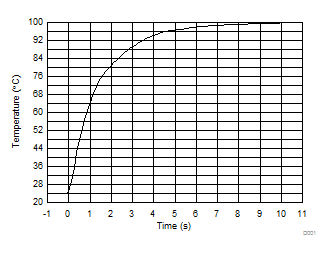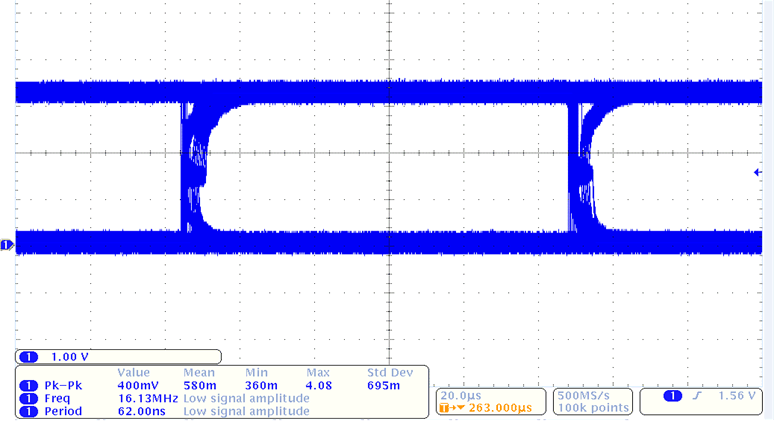JAJSGF6D May 2015 – January 2020 TMP107
PRODUCTION DATA.
- 1 特長
- 2 アプリケーション
- 3 概要
- 4 改訂履歴
- 5 Pin Configuration and Functions
- 6 Specifications
-
7 Detailed Description
- 7.1 Overview
- 7.2 Functional Block Diagram
- 7.3 Feature Description
- 7.4 Device Functional Modes
- 7.5 Programming
- 7.6
Register Map
- 7.6.1 Temperature Register (address = 0h) [reset = 0h]
- 7.6.2 Configuration Register (address = 1h) [reset = A000h]
- 7.6.3 High Limit 1 Register (address = 2h) [reset = 7FFCh]
- 7.6.4 Low Limit 1 Register (address = 3h) [reset = 8000h]
- 7.6.5 High Limit 2 Register (address = 4h) [reset = 7FFCh]
- 7.6.6 Low Limit 2 Register (address = 5h) [reset = 8000h]
- 7.6.7 EEPROM n Register (where n = 1 to 8) (addresses = 6h to Dh) [reset = 0h]
- 7.6.8 Die ID Register (address = Fh) [reset = 1107h]
- 8 Application and Implementation
- 9 Power Supply Recommendations
- 10Layout
- 11デバイスおよびドキュメントのサポート
- 12メカニカル、パッケージ、および注文情報
8.2.1.3 Application Curves
Figure 40 shows the step response of the TMP107 to a submersion in an oil bath of 100ºC from room temperature (24ºC) at a 3.3-V supply. The time-constant, or the time for the output to reach 63% of the input step, is 1.375 s. The time-constant depends on the printed-circuit board (PCB) that the device is mounted on. For this test, the device is soldered to a two-layer PCB that measures 0.551 in × 0.748 in.
Figure 41 shows the TMP107 eye diagram as a measure of quality for the transmission path (cable). Measurement of eye patterns is performed by a setup where a source generates a known bit stream that is fed into a transmission channel. The eye diagram of TMP107 is taken on the I/O line at the far end of a 300-meter cable connecting two TMP107 devices. The baud rate is 9600 bps, and the supply voltage is set to 3.3 V. The scope is set to trigger on I/O rising (or falling) edge, with an infinite persistent time. The superimposed, captured waveforms create the eye diagram. Excellent eye diagram parameters are maintained at 9600 bps speed.

